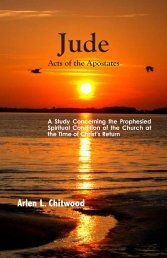Signs in John's Gospel - The Lamp Broadcast
Signs in John's Gospel - The Lamp Broadcast
Signs in John's Gospel - The Lamp Broadcast
You also want an ePaper? Increase the reach of your titles
YUMPU automatically turns print PDFs into web optimized ePapers that Google loves.
Except a Man… (III) 101<br />
For more detailed <strong>in</strong>formation on firstborn Sons [Christ, Israel,<br />
and the Church], along with <strong>in</strong>formation on the redemption of the<br />
<strong>in</strong>heritance [through which those Christians shown worthy at the<br />
judgment seat will become Christ’s wife], refer to the author’s<br />
books, GOD’S FIRSTBORN SONS and RUTH.)<br />
James<br />
<strong>The</strong> epistle of James was written to deal with faithfulness, from<br />
several vantage po<strong>in</strong>ts.<br />
In the first chapter faithfulness has to do with endur<strong>in</strong>g temptation<br />
(vv. 2-12) and, correspond<strong>in</strong>gly, with hav<strong>in</strong>g been brought<br />
forth from above (v. 18). And endur<strong>in</strong>g temptation <strong>in</strong> this manner<br />
is seen hav<strong>in</strong>g to do with crowns <strong>in</strong> relation to the sav<strong>in</strong>g of the soul<br />
(vv. 12, 21).<br />
<strong>The</strong>n chapter two, hav<strong>in</strong>g to do with another facet of the same<br />
th<strong>in</strong>g, centers around works emanat<strong>in</strong>g out of faith, br<strong>in</strong>g<strong>in</strong>g faith<br />
to its proper goal (vv. 14-26). And this goal is the same as that<br />
seen <strong>in</strong> chapter one, hav<strong>in</strong>g to do with crowns and the sav<strong>in</strong>g of<br />
the soul, with a view to an <strong>in</strong>heritance <strong>in</strong> the k<strong>in</strong>gdom (cf. James 2:5;<br />
I Peter 1:9; Heb. 11:1ff).<br />
And the rema<strong>in</strong><strong>in</strong>g three chapters have to do with different<br />
facets of the same subject, end<strong>in</strong>g aga<strong>in</strong> with the sav<strong>in</strong>g of the soul<br />
(5:19, 20).<br />
<strong>The</strong> manner <strong>in</strong> which James presents a br<strong>in</strong>g<strong>in</strong>g forth from<br />
above <strong>in</strong> the first chapter can be of immense help <strong>in</strong> understand<strong>in</strong>g<br />
this overall subject, for James presents not only a br<strong>in</strong>g<strong>in</strong>g<br />
forth from above but he precedes this by present<strong>in</strong>g a br<strong>in</strong>g<strong>in</strong>g<br />
forth from below (vv. 15-18). And it is Christians who are seen <strong>in</strong><br />
both <strong>in</strong>stances, either exercis<strong>in</strong>g faith and be<strong>in</strong>g brought forth from<br />
above or not exercis<strong>in</strong>g faith and be<strong>in</strong>g brought forth from below. No<br />
middle ground exists. It is either one or the other (Matt. 12:30;<br />
Luke 11:23).<br />
Verse fifteen shows a br<strong>in</strong>g<strong>in</strong>g forth from below; then verse eighteen<br />
shows a br<strong>in</strong>g<strong>in</strong>g forth from above. In verse fifteen, the Greek<br />
words tikto (“to beget,” “to br<strong>in</strong>g forth”) and apokueo (“to br<strong>in</strong>g<br />
forth,” “to give birth” [as seen <strong>in</strong> a medical respect]) are used <strong>in</strong>



